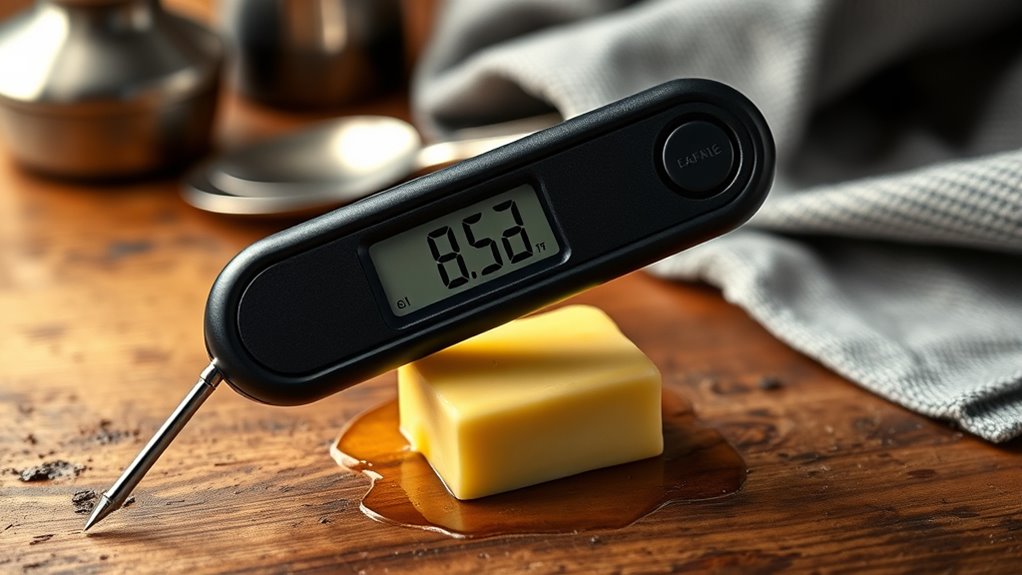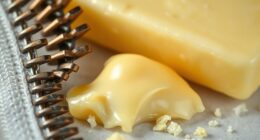To assess the accuracy of infrared butter thermometers, you need to guarantee proper calibration and adjust for the butter’s surface emissivity. Keep the device clean, measure from the recommended distance and angle, and avoid environmental factors like steam or reflective surfaces that can distort readings. Regular calibration using a reliable standard helps maintain precision. Keep these tips in mind, and you’ll get reliable results every time—continue exploring for detailed guidance on ideal use.
Key Takeaways
- Regular calibration against standard temperature sources ensures infrared thermometers maintain accuracy for butter measurements.
- Adjusting emissivity settings based on butter’s surface properties improves measurement precision.
- Environmental factors like steam, humidity, and airflow can affect infrared readings, requiring controlled measurement conditions.
- Proper distance and angle during measurement minimize errors caused by surface reflectivity and emissivity variations.
- Routine cleaning of the lens and minimizing surface reflections enhance the reliability of infrared thermometer accuracy.
How Infrared Thermometers Measure Temperature

Infrared thermometers measure temperature by detecting the heat emitted from an object’s surface. To guarantee accurate readings, you need to perform infrared sensor calibration regularly. This process aligns the sensor’s output with known temperature standards, minimizing errors. Additionally, adjusting for emissivity is essential, as different surfaces emit infrared radiation differently. You’ll need to set the correct emissivity value based on the material you’re measuring, whether it’s shiny metal or matte plastic. Proper calibration and emissivity adjustment help your infrared thermometer provide precise temperature readings, especially for objects like butter, which have specific emissivity characteristics. Understanding emissivity and maintaining these settings are crucial for accurate measurements. By keeping these factors in check, you can rely on your device for consistent and accurate measurements every time.
Factors Affecting Measurement Accuracy

Measurement accuracy can be influenced by several factors beyond calibration and emissivity settings. Calibration issues are common if your thermometer isn’t regularly checked against a reliable standard, leading to inaccurate readings. Surface emissivity also plays a vital role; different surfaces emit infrared radiation differently, affecting measurement precision. If you ignore surface emissivity, the thermometer may misinterpret temperature, especially with shiny or reflective surfaces. Additionally, environmental factors like dust, steam, or ambient temperature fluctuations can interfere with readings. Properly calibrating your device and accounting for surface emissivity are essential steps to guarantee accuracy. Always verify calibration regularly and consider surface characteristics when measuring temperature, especially in diverse conditions, to obtain reliable and consistent results. Being aware of measurement conditions can further improve the reliability of your infrared thermometer readings.
Comparing Infrared and Traditional Thermometers

While traditional thermometers rely on physical contact to gauge temperature, infrared thermometers measure heat from a distance by detecting emitted infrared radiation. This method offers quick, non-contact readings, but accuracy depends heavily on proper infrared calibration and understanding surface emissivity. Infrared thermometers assume a consistent emissivity, often around 0.95, but variations in surface properties can cause discrepancies. Traditional thermometers, like mercury or digital probes, directly measure temperature without concern for surface emissivity, often providing more precise readings on various surfaces. However, they require contact, which can introduce errors if not used correctly. When comparing both types, consider the surface characteristics and calibration needs, as infrared readings can be affected by factors that traditional thermometers bypass entirely. Additionally, understanding surface emissivity is crucial, as it influences the accuracy of infrared measurements across different materials.
Tips for Ensuring Reliable Readings

To guarantee you get accurate readings from your infrared butter thermometer, it’s vital to follow some key tips. First, regularly perform calibration techniques to ensure your device remains precise. Proper user training is essential; familiarize yourself with the thermometer’s features and correct measurement procedures. Keep the lens clean and free of grease or debris, which can distort readings. Always measure at the same angle and distance for consistency. Avoid measuring through glass or reflective surfaces, which can affect accuracy. Store the thermometer in a stable environment, away from temperature fluctuations. Additionally, be aware of potential infrared sensor vulnerabilities that can impact measurement reliability. By applying these tips, you’ll improve reliability and maintain the thermometer’s performance over time.
Best Practices for Using Infrared Butter Thermometers

Using your infrared butter thermometer correctly is essential for getting accurate and consistent readings. Start by regularly applying calibration techniques to ensure the device remains precise. Check for accuracy against a known temperature source and recalibrate as needed. Be mindful of environmental influences, such as ambient temperature, humidity, and airflow, which can affect readings. Always allow your thermometer to acclimate to the environment before use, and avoid measuring through steam or condensation that can distort results. Keep the lens clean and free from grease or dirt to prevent measurement errors. Position the thermometer at the correct distance and angle from the butter surface, following the manufacturer’s guidelines. Properly understanding and managing environmental influences can significantly improve measurement accuracy. By adhering to proper calibration techniques and accounting for environmental influences, you’ll maximize your infrared thermometer’s accuracy.
Frequently Asked Questions
What Is the Typical Lifespan of an Infrared Butter Thermometer?
The typical lifespan of an infrared butter thermometer depends on factors like battery life and calibration intervals. You can usually expect it to last around 2 to 5 years with proper care. Regularly replacing batteries ensures consistent function, and following calibration intervals helps maintain accuracy. By handling it carefully and performing routine checks, you maximize its lifespan and keep your temperature readings dependable over time.
How Do Environmental Conditions Impact Infrared Thermometer Accuracy?
Think of your infrared thermometer as a sensitive camera that captures surface heat. Ambient temperature can distort it, like trying to take a clear photo in foggy weather. If the surface emissivity isn’t matched correctly, the device might give skewed readings—similar to trying to see through tinted glasses. To guarantee accuracy, keep the environment stable and adjust for surface emissivity as needed.
Are Infrared Thermometers Safe for Use With Hot or Sticky Substances?
When using infrared thermometers on hot or sticky substances, safety concerns and hot surface risks come into play. You should be cautious because the thermometer’s sensor might get sticky or damaged, and direct contact isn’t necessary. However, avoid pointing it at very hot surfaces for extended periods to prevent damage and guarantee accurate readings. Always follow manufacturer instructions to minimize risks and keep safe during use.
Can Infrared Thermometers Be Calibrated for Specific Dairy Products?
You can calibrate infrared thermometers for specific dairy products by following proper calibration procedures. This involves making product-specific adjustments to account for variations in texture, moisture, and surface properties. Regular calibration guarantees accurate readings across different dairy items like milk, cheese, or yogurt. By performing these adjustments, you improve measurement reliability, helping to maintain quality and safety standards in dairy processing and storage.
What Maintenance Is Required to Keep Infrared Thermometers Accurate?
To keep your infrared thermometer precise, perform frequent sensor cleaning to clear dust and debris that can distort readings. Regularly check and replace batteries to prevent power issues that affect accuracy. Handle the device carefully, avoiding shocks and extreme temperatures, and store it properly to preserve performance. Consistent calibration and maintenance guarantee your thermometer remains reliable, giving you clear, correct readings whenever you need them.
Conclusion
By mastering your infrared butter thermometer, you’ll unveil the secret to perfect baking every time—no more guessing, no more burnt or undercooked butter. With precision so sharp it could cut through doubt, you’ll become a kitchen wizard, turning average meals into culinary masterpieces. Remember, a reliable reading isn’t just a number; it’s the key to baking perfection. Embrace these tips, and watch your cooking transform from good to legendary overnight!










